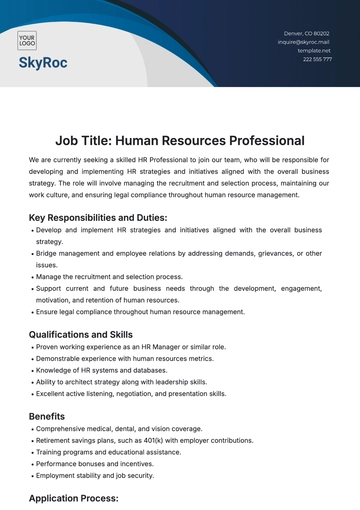Free KRA for HR Professional

Prepared by: [YOUR NAME]
Email: [YOUR EMAIL]
In today’s dynamic business landscape, the role of HR professionals has evolved significantly. Establishing clear Key Result Areas (KRAs) is essential for aligning HR initiatives with organizational goals and enhancing overall effectiveness. This document outlines a KRA framework that can guide HR professionals in achieving their strategic objectives.
I. Performance Evaluation
Objective: To assess the effectiveness of HR initiatives and employee performance to drive continuous improvement.
KRA Component | Description | Measurement Criteria | Frequency | Responsible Party |
|---|---|---|---|---|
Performance Metrics | Establish KPIs for employee performance evaluations. | KPIs developed and communicated. | Annually | HR Manager |
Review Process | Implement a structured performance review process. | Completion rate of reviews. | Bi-Annually | HR Team |
Feedback Mechanism | Gather feedback from employees on performance reviews. | Employee satisfaction scores. | Quarterly | HR Team |
II. Goal Setting
Objective: To create SMART goals for HR initiatives that align with the broader organizational strategy.
KRA Component | Description | Measurement Criteria | Frequency | Responsible Party |
|---|---|---|---|---|
SMART Goals | Define specific, measurable, achievable, relevant, and time-bound goals for HR. | Percentage of goals met. | Annually | HR Director |
Alignment with Strategy | Ensure HR goals support organizational objectives. | Alignment score from management. | Annually | HR Manager |
Reporting | Create a report on goal achievement and strategic alignment. | Report submitted on time. | Annually | HR Team |
III. Strategic Alignment
Objective: To ensure that HR practices and policies support the overall business strategy.
KRA Component | Description | Measurement Criteria | Frequency | Responsible Party |
|---|---|---|---|---|
Policy Review | Regularly review HR policies for alignment with business goals. | Number of policies updated. | Bi-Annually | HR Manager |
Stakeholder Engagement | Engage with key stakeholders to gather input on HR strategies. | Stakeholder feedback scores. | Quarterly | HR Director |
Training Alignment | Ensure training programs align with organizational needs. | Training effectiveness metrics. | Annually | HR Team |
IV. Resource Allocation
Objective: To optimize resource allocation in HR to enhance operational efficiency.
KRA Component | Description | Measurement Criteria | Frequency | Responsible Party |
|---|---|---|---|---|
Budget Management | Develop and manage the HR budget effectively. | Budget variance analysis. | Quarterly | HR Manager |
Staffing Needs | Analyze staffing needs to ensure adequate coverage. | Staffing metrics report. | Annually | HR Team |
Resource Utilization | Track resource utilization across HR functions. | Utilization rates. | Quarterly | HR Manager |
V. Training and Development
Objective: To enhance employee skills and career growth through targeted training initiatives.
KRA Component | Description | Measurement Criteria | Frequency | Responsible Party |
|---|---|---|---|---|
Training Programs | Develop and implement training programs based on needs assessment. | Number of programs conducted. | Annually | HR Team |
Skill Development | Monitor the skill development progress of employees. | Skill assessment scores. | Bi-Annually | HR Manager |
Budget for Training | Allocate budget effectively for training initiatives. | Training budget adherence. | Annually | HR Director |
Conclusion
The outlined Key Result Areas provide a robust framework for HR professionals, enabling them to focus on critical areas that drive organizational success. By implementing these KRAs, HR can enhance performance evaluation, goal setting, strategic alignment, resource allocation, and training and development initiatives, ultimately contributing to a more engaged and effective workforce.
- 100% Customizable, free editor
- Access 1 Million+ Templates, photo’s & graphics
- Download or share as a template
- Click and replace photos, graphics, text, backgrounds
- Resize, crop, AI write & more
- Access advanced editor
Maximize your HR potential with the KRA for HR Professional Template from Template.net. This customizable and editable template simplifies the creation of Key Result Areas, ensuring alignment with your organization's goals. Powered by our AI Editor Tool, it allows for effortless modifications, saving time while improving clarity and focus in performance management.





























